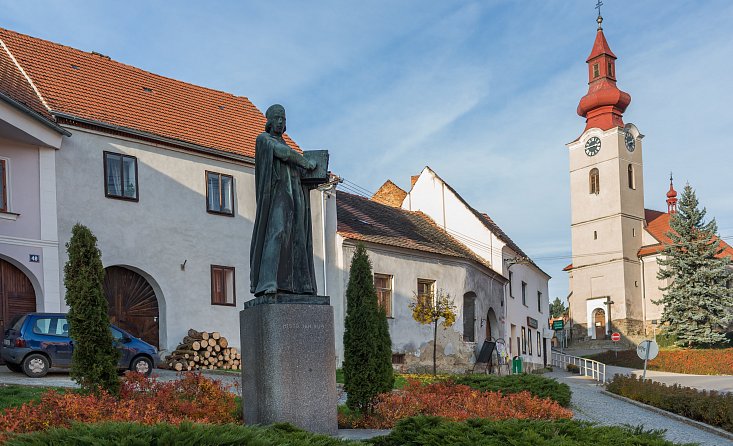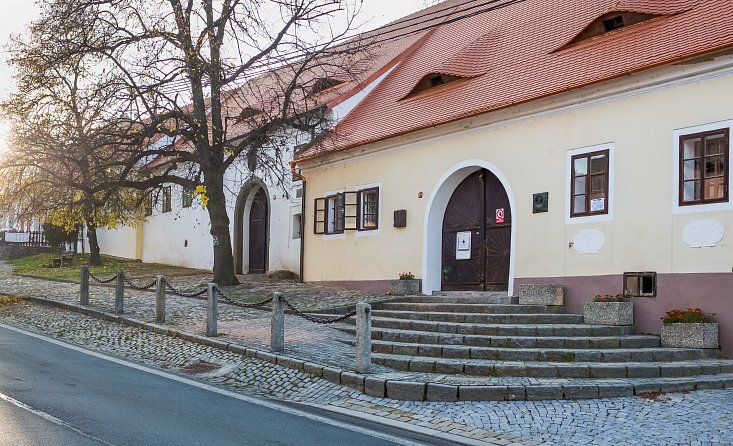

"According to the chronicles of Prince Boleslav I, in 942, he sent all the subordinate people to the countryside, who did not want to accept the Christian faith to pour the gold from which the prince named the tithe."
THE FIRST WRITTEN CHRISTMAS OF HUSINI IS FROM 1291 WHERE IT IS CHANGED AS ANOTHER WOMEN FROM THE BORK AND HUSINCE, SUCH AS THE MEETING OF THE LANDSCAPE COURT. THE FOLLOWING OF 1359 ALTERNATES HUSINEC AS A NON-FURNISHED MESETEK. IN THE SAME YEAR, EVERY CHURCH IS RECOMMENDED.
Jan Hus's native house
The oldest report on Hus's native house in Husinec is written in the early 17th century in the preaching of Havel Žalanský: Parents Master Jan Hus was poor, because the place so far shows up
where he had his dwelling. "
The report of Krumlov Archbekel Kleeblatt from 1633 states that:
"The Husines show the house in which the Hus was born and cut off chips from his toothache."
The first known owner of us was in 1634 the Hake Tailor Zikmund Nna. 20 years later, the house was burned out. In 1691 the house was burned again. The other owners were Tramach, Suster
and in 1740 the baker Josef Jileček. At the beginning of the 19th century, the family of Jilečků ran wine-making.
Poet Franz Turin, after visiting the house, wrote:
"It is his house! The hut? Yes, come on!
Three stairs higher! On the left hand is Huso!
Who speaks loud speech, tell us my son!
Behold, the vintage is here! The neighbors have come together!
Unbelievable sin! Ladies and Gentlemen Shame!
There was glory and honor! Pay here for her loss! "
During the celebrations in 1869, Hus's relief from Bohuslav Schnirch was unveiled at the house. In 1871 he visited the house of Jan Neruda. In 1873, Hus's room was rented from the owners,
in 1883 the front part of the cottage was bought by Svatobor. In 1952, a museum was opened in the house. Another modification was made in 1965. National cultural monument
since 1958. The house was reconstructed in 2015.
Hus statue
The first attempt to build the Hus Monument is recorded in 1928. Unfortunately, only the foundation stone was laid. He is still seen in the backyard of his native house.
Since 1958, the statue of Jan Hus has been painted at the upper end of Prokop's Square with the Scriptures written by Professor Karel Lidický. It is 290 centimeters tall and is identical to the statue placed
four years earlier in Karolinum, Prague.
The inauguration of the Hussite sculpture took place on 6 July and the main speech was held by the then Minister of Justice dr. V. Škoda. The celebration program culminated in an afternoon concert
The Czechoslovak state ensemble of songs and dances.
More route tips
Jan Hus's native house
Hus statue
Hus festival
The first Hus celebrations took place in Husinec in 1868 and reminded John's death by a procession from the town hall to his native house. Larger celebrations took place a year later, commemorating the alleged five-year anniversary of his birth. The preparatory committee was formed by the vimperský doctor dr. Josef Wieser or Secretary of the District Council in Strakonice Česlav Augustin Ludikar. The Committee asks the municipality of Husinecko to "provide the necessary material for the construction of the gates ... to illuminate all the windows in the front streets, the square to decorate all the houses, and Hussein on the hills to be equipped with festive fire". His own celebrations on September 6, 1869 were attended by sixty thousand people. The solemn speech was given by the prominent Czech politician, Karel Sladkovský: "Publicly, Master Jene Hus, we proudly call ourselves the world before you, and we want you to honor and celebrate your memory, if the name of the Czech name lasts. We do not care if others are kasting you, no more needing to set you in a line of saints. "
Regular celebration takes place only after the Second World War. The celebration is attended by famous guests (General Ludvík Svoboda, Čestmír Císař, Petr Pithart, Cardinal Vlk, Václav Havel, Václav Klaus) as well as popular artists (Marie Rottrová, Eva Pilarová, Milan Drobný).
Josef Krais's native house, studio and sgraffito
Husinecký native, the pupil of Franz Alta and Maxmilian Pirner, made a sgraffito decoration with Czech national and historical motifs at the House No. 42 in the time of the German Nazi proclamation: "Well, we had to rob the whole house first, dismantle and then for my personal presence to re-cast each move. But the house of Lord Fidler is the most beautiful in the whole Hus county. Decorative fillings, historical figures of our nation, features of South Bohemian families. "
Other Krejs sgraffiti - sv. Václava, sv. Jiří a sv. Martina can be found at the house no. 126, in the pub's pub no. 44 or within the cemetery church.



